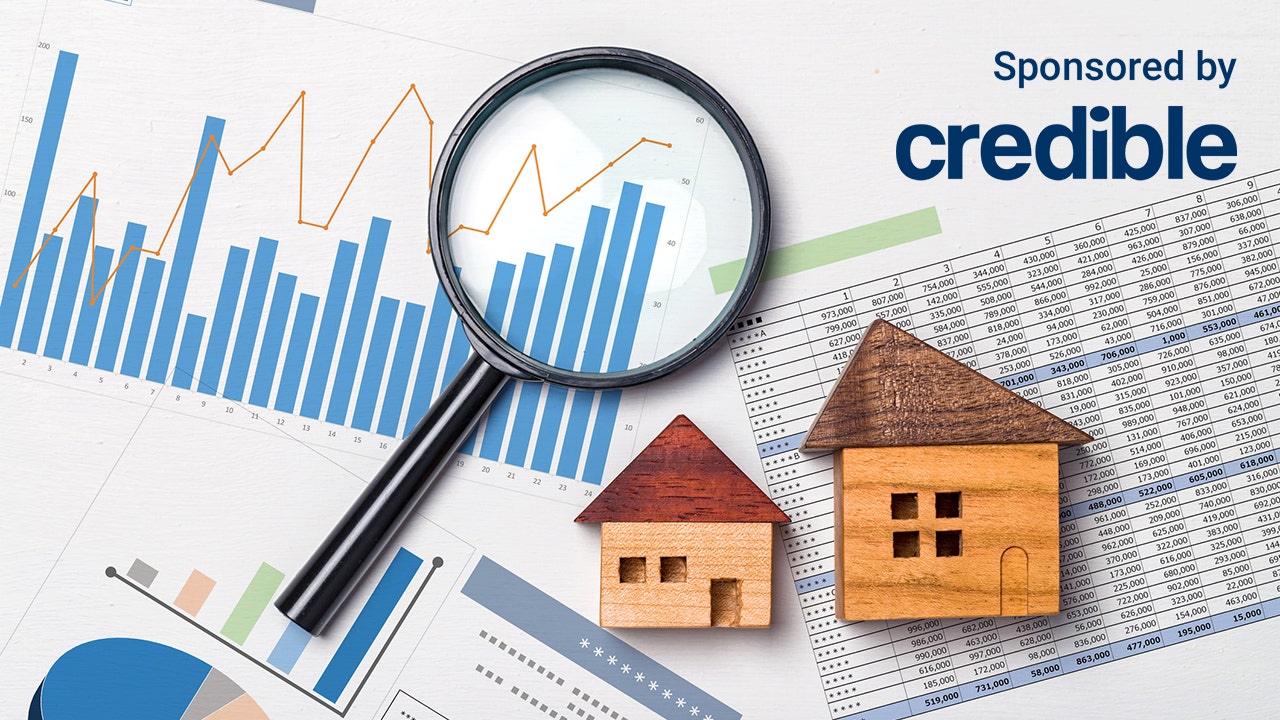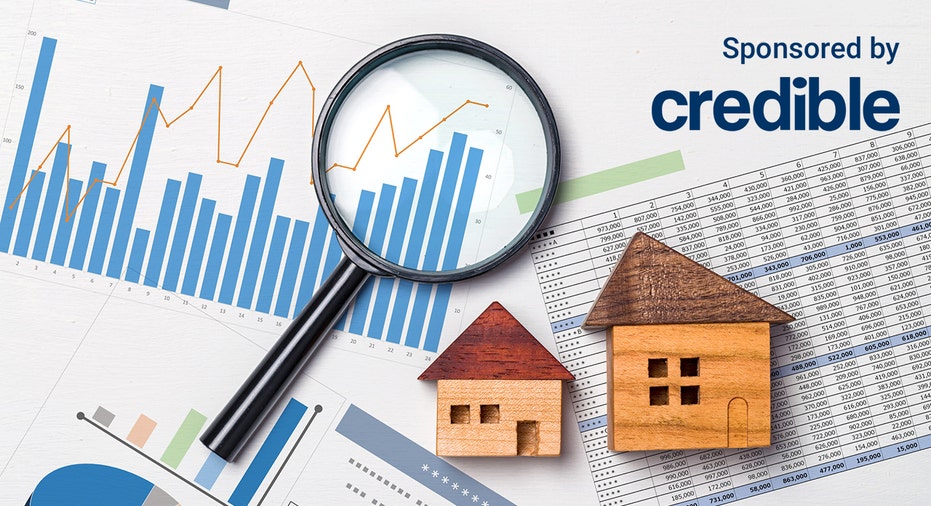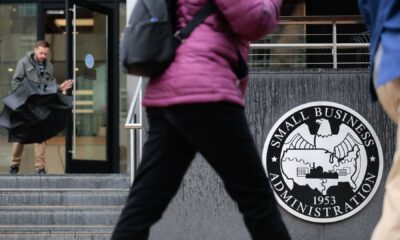Finance
Today’s 15- and 30-year mortgage rates hold steady | April 3, 2024
Published
12 months agoon

Our goal here at Credible Operations, Inc., NMLS Number 1681276, referred to as “Credible” below, is to give you the tools and confidence you need to improve your finances. Although we do promote products from our partner lenders who compensate us for our services, all opinions are our own.

Mortgage rates fluctuate almost daily based on economic conditions. Here are today’s mortgage rates and what you need to know about getting the best rate. (iStock)
The interest rate on a 30-year fixed-rate mortgage is 7.125% as of April 3, which is unchanged from yesterday. Additionally, the interest rate on a 15-year fixed-rate mortgage is 6.125%, which is also unchanged from yesterday.
With mortgage rates changing daily, it’s a good idea to check today’s rate before applying for a loan. It’s also important to compare different lenders’ current interest rates, terms, and fees to ensure you get the best deal.
Rates last updated on April 3, 2024. Rates are based on the assumptions shown here. Actual rates may vary. Credible, a personal finance marketplace, has 5,000 Trustpilot reviews with an average star rating of 4.7 (out of a possible 5.0).
How do mortgage rates work?
When you take out a mortgage loan to purchase a home, you’re borrowing money from a lender. In order for that lender to make a profit and reduce risk to itself, it will charge interest on the principal — that is, the amount you borrowed.
Expressed as a percentage, a mortgage interest rate is essentially the cost of borrowing money. It can vary based on several factors, such as your credit score, debt-to-income ratio (DTI), down payment, loan amount, and repayment term.
After getting a mortgage, you’ll typically receive an amortization schedule, which shows your payment schedule over the life of the loan. It also indicates how much of each payment goes toward the principal balance versus the interest.
Near the beginning of the loan term, you’ll spend more money on interest and less on the principal balance. As you approach the end of the repayment term, you’ll pay more toward the principal and less toward interest.
Your mortgage interest rate can be either fixed or adjustable. With a fixed-rate mortgage, the rate will be consistent for the duration of the loan. With an adjustable-rate mortgage (ARM), the interest rate can fluctuate with the market.
Keep in mind that a mortgage’s interest rate is not the same as its annual percentage rate (APR). This is because an APR includes both the interest rate and any other lender fees or charges.
Mortgage rates change frequently — sometimes on a daily basis. Inflation plays a significant role in these fluctuations. Interest rates tend to rise in periods of high inflation, whereas they tend to drop or remain roughly the same in times of low inflation. Other factors, like the economic climate, demand, and inventory can also impact the current average mortgage rates.
To find great mortgage rates, start by using Credible’s secured website, which can show you current mortgage rates from multiple lenders without affecting your credit score. You can also use Credible’s mortgage calculator to estimate your monthly mortgage payments.
What determines the mortgage rate?
Mortgage lenders typically determine the interest rate on a case-by-case basis. Generally, they reserve the lowest rates for low-risk borrowers — that is, those with a higher credit score, income, and down payment amount. Here are some other personal factors that may determine your mortgage rate:
- Location of the home
- Price of the home
- Your credit score and credit history
- Loan term
- Loan type (e.g., conventional or FHA)
- Interest rate type (fixed or adjustable)
- Down payment amount
- Loan-to-value (LTV) ratio
- DTI
Other indirect factors that may determine the mortgage rate include:
- Current economic conditions
- Rate of inflation
- Market conditions
- Housing construction supply, demand, and costs
- Consumer spending
- Stock market
- 10-year Treasury yields
- Federal Reserve policies
- Current employment rate
How to compare mortgage rates
Along with certain economic and personal factors, the lender you choose can also affect your mortgage rate. Some lenders have higher average mortgage rates than others, regardless of your credit or financial situation. That’s why it’s important to compare lenders and loan offers.
Here are some of the best ways to compare mortgage rates and ensure you get the best one:
- Shop around for lenders: Compare several lenders to find the best rates and lowest fees. Even if the rate is only lower by a few basis points, it could still save you thousands of dollars over the life of the loan.
- Get several loan estimates: A loan estimate comes with a more personalized rate and fees based on factors like income, employment, and the property’s location. Review and compare loan estimates from several lenders.
- Get pre-approved for a mortgage: Pre-approval doesn’t guarantee you’ll get a loan, but it can give you a better idea of what you qualify for and at what interest rate. You’ll need to complete an application and undergo a hard credit check.
- Consider a mortgage rate lock: A mortgage rate lock lets you lock in the current mortgage rate for a certain amount of time — often between 30 and 90 days. During this time, you can continue shopping around for a home without worrying about the rate changing.
- Choose between an adjustable- and fixed-rate mortgage: The interest rate type can affect how much you pay over time, so consider your options carefully.
One other way to compare mortgage rates is with a mortgage calculator. Use a calculator to determine your monthly payment amount and the total cost of the loan. Just remember, certain fees like homeowners insurance or taxes might not be included in the calculations.
Here’s a simple example of what a 15-year fixed-rate mortgage might look like versus a 30-year fixed-rate mortgage:
15-year fixed-rate
- Loan amount: $300,000
- Interest rate: 6.29%
- Monthly payment: $2,579
- Total interest charges: $164,186
- Total loan amount: $464,186
30-year fixed-rate
- Loan amount: $300,000
- Interest rate: 6.89%
- Monthly payment: $1,974
- Total interest charges: $410,566
- Total loan amount: $710,565
Pros and cons of mortgages
If you’re thinking about taking out a mortgage, here are some benefits to consider:
- Predictable monthly payments: Fixed-rate mortgage loans come with a set interest rate that doesn’t change over the life of the loan. This means more consistent monthly payments.
- Potentially low interest rates: With good credit and a high down payment, you could get a competitive interest rate. Adjustable-rate mortgages may also come with a lower initial interest rate than fixed-rate loans.
- Tax benefits: Having a mortgage could make you eligible for certain tax benefits, such as a mortgage interest deduction.
- Potential asset: Real estate is often considered an asset. As you pay down your loan, you can also build home equity, which you can use for other things like debt consolidation or home improvement projects.
- Credit score boost: With on-time payments, you can build your credit score.
And here are some of the biggest downsides of getting a mortgage:
- Expensive fees and interest: You could end up paying thousands of dollars in interest and other fees over the life of the loan. You will also be responsible for maintenance, property taxes, and homeowners insurance.
- Long-term debt: Taking out a mortgage is a major financial commitment. Typical loan terms are 10, 15, 20, and 30 years.
- Potential rate changes: If you get an adjustable rate, the interest rate could increase.
How to qualify for a mortgage
Requirements vary by lender, but here are the typical steps to qualify for a mortgage:
- Have steady employment and income: You’ll need to provide proof of income when applying for a home loan. This may include money from your regular job, alimony, military benefits, commissions, or Social Security payments. You may also need to provide proof of at least two years’ worth of employment at your current company.
- Review any assets: Lenders consider your assets when deciding whether to lend you money. Common assets include money in your bank account or investment accounts.
- Know your DTI: Your DTI is the percentage of your gross monthly income that goes toward your monthly debts — like installment loans, lines of credit, or rent. The lower your DTI, the better your approval odds.
- Check your credit score: To get the best mortgage rate possible, you’ll need to have good credit. However, each loan type has a different credit score requirement. For example, you’ll need a credit score of 580 or higher to qualify for an FHA loan with a 3.5% down payment.
- Know the property type: During the loan application process, you may need to specify whether the home you want to buy is your primary residence. Lenders often view a primary residence as less risky, so they may have more lenient requirements than if you were to get a secondary or investment property.
- Choose the loan type: Many types of mortgage loans exist, including conventional loans, VA loans, USDA loans, FHA loans, and jumbo loans. Consider your options and pick the best one for your needs.
- Prepare for upfront and closing costs: Depending on the loan type, you may need to make a down payment. The exact amount depends on the loan type and lender. A USDA loan, for example, has no minimum down payment requirement for eligible buyers. With a conventional loan, you’ll need to put down 20% to avoid private mortgage insurance (PMI). You may also be responsible for paying any closing costs when signing for the loan.
How to apply for a mortgage
Here are the basic steps to apply for a mortgage, and what you can typically expect during the process:
- Choose a lender: Compare several lenders to see the types of loans they offer, their average mortgage rates, repayment terms, and fees. Also, check if they offer any down payment assistance programs or closing cost credits.
- Get pre-approved: Complete the pre-approval process to boost your chances of getting your dream home. You’ll need identifying documents, as well as documents verifying your employment, income, assets, and debts.
- Submit a formal application: Complete your chosen lender’s application process — either in person or online — and upload any required documents.
- Wait for the lender to process your loan: It can take some time for the lender to review your application and make a decision. In some cases, they may request additional information about your finances, assets, or liabilities. Provide this information as soon as possible to prevent delays.
- Complete the closing process: If approved for a loan, you’ll receive a closing disclosure with information about the loan and any closing costs. Review it, pay the down payment and closing costs, and sign the final loan documents. Some lenders have an online closing process, while others require you to go in person. If you are not approved, you can talk to your lender to get more information and determine how you can remedy any issues.
How to refinance a mortgage
Refinancing your mortgage lets you trade your current loan for a new one. It does not mean taking out a second loan. You will also still be responsible for making payments on the refinanced loan.
You might want to refinance your mortgage if you:
- Want a lower interest rate or different rate type
- Are looking for a shorter repayment term so you can pay off the loan sooner
- Need a smaller monthly payment
- Want to remove the PMI from your loan
- Need to use the equity for things like home improvement or debt consolidation (cash-out refinancing)
The refinancing process is similar to the process you follow for the original loan. Here are the basic steps:
- Choose the type of refinancing you want.
- Compare lenders for the best rates.
- Complete the application process.
- Wait for the lender to review your application.
- Provide supporting documentation (if requested).
- Complete the home appraisal.
- Proceed to closing, review the loan documents, and pay any closing costs.
How to access your home’s equity
If you need to tap into your home’s equity to pay off debt, fund a renovation, or cover an emergency expense, there are two popular options to choose from: a home equity loan and a home equity line of credit (HELOC). Both a home equity loan and a HELOC allow you to borrow against your home’s equity but a home equity loan comes in the form of a lump sum payment and a HELOC is a revolving line of credit.
These two loan types have some other key similarities and differences in how they work:
| Home equity loan | Home equity line of credit (HELOC) | |
| Interest rate | Fixed | Variable |
| Monthly payment amount | Fixed | Variable |
| Closing costs and fees | Yes | Yes, might be lower than other loan types |
| Repayment period | Typically 5-30 years | Typically 10-20 years |
FAQ
What is a rate lock?
Interest rates on mortgages fluctuate all the time, but a rate lock allows you to lock in your current rate for a set amount of time. This ensures you get the rate you want as you complete the homebuying process.
What are mortgage points?
Mortgage points are a type of prepaid interest that you can pay upfront — often as part of your closing costs — for a lower overall interest rate. This can lower your APR and monthly payments.
What are closing costs?
Closing costs are the fees you, as the buyer, need to pay before getting a loan. Common fees include attorney fees, home appraisal fees, origination fees, and application fees.
If you’re trying to find the right mortgage rate, consider using Credible. You can use Credible’s free online tool to easily compare multiple lenders and see prequalified rates in just a few minutes.
You may like
Finance
Tariffs may raise much less than White House projects, economists say
Published
20 minutes agoon
April 1, 2025
President Donald Trump speaks before signing executive orders in the Oval Office on March 6, 2025.
Alex Wong | Getty Images
President Donald Trump says that tariffs will make the U.S. “rich.” But those riches will likely be far less than the White House expects, economists said.
The ultimate sum could have big ramifications for the U.S. economy, the nation’s debt and legislative negotiations over a tax-cut package, economists said.
White House trade adviser Peter Navarro on Sunday estimated tariffs would raise about $600 billion a year and $6 trillion over a decade. Auto tariffs would add another $100 billion a year, he said on “Fox News Sunday.”
Navarro made the projection as the U.S. plans to announce more tariffs against U.S. trading partners on Wednesday.
Economists expect the Trump administration’s tariff policy would generate a much lower amount of revenue than Navarro claims. Some project the total revenue would be less than half.
Roughly $600 billion to $700 billion a year “is not even in the realm of possibility,” said Mark Zandi, chief economist at Moody’s. “If you get to $100 billion to $200 billion, you’ll be pretty lucky.”
The White House declined to respond to a request for comment from CNBC about tariff revenue.
The ‘mental math’ behind tariff revenue
There are big question marks over the scope of the tariffs, including details like amount, duration, and products and countries affected — all of which have a significant bearing on the revenue total.
The White House is considering a 20% tariff on most imports, The Washington Post reported on Tuesday. President Trump floated this idea on the campaign trail. The Trump administration may ultimately opt for a different policy, like country-by-country tariffs based on each nation’s respective trade and non-trade barriers.
But a 20% tariff rate seems to align with Navarro’s revenue projections, economists said.
The U.S. imported about $3.3 trillion of goods in 2024. Applying a 20% tariff rate to all these imports would yield about $660 billion of annual revenue.
“That is almost certainly the mental math Peter Navarro is doing — and that mental math skips some crucial steps,” said Ernie Tedeschi, director of economics at the Yale Budget Lab and former chief economist at the White House Council of Economic Advisers during the Biden administration.
Trade advisor to U.S. President Donald Trump Peter Navarro speaks to press outside of the White House on March 12, 2025 in Washington, DC.
Kayla Bartkowski | Getty Images
That’s because an accurate revenue estimate must account for the many economic impacts of tariffs in the U.S. and around the world, economists said. Those effects combine to reduce revenue, they said.
A 20% broad tariff would raise about $250 billion a year (or $2.5 trillion over a decade) when taking those effects into account, according to Tedeschi, citing a Yale Budget Lab analysis published Monday.
There are ways to raise larger sums — but they would involve higher tariff rates, economists said. For example, a 50% across-the-board tariff would raise about $780 billion per year, according to economists at the Peterson Institute for International Economics.
Even that is an optimistic assessment: It doesn’t account for lower U.S. economic growth due to retaliation or the negative growth effects from the tariffs themselves, they wrote.
Why revenue would be lower than expected
Tariffs generally raise prices for consumers. A 20% broad tariff would cost the average consumer $3,400 to $4,200 a year, according to the Yale Budget Lab.
Consumers would naturally buy fewer imported goods if they cost more, economists said. Lower demand means fewer imports and less tariff revenue from those imports, they said.
Tariffs are also expected to trigger “reduced economic activity,” said Robert McClelland, senior fellow at the Urban-Brookings Tax Policy Center.
More from Personal Finance:
Economists say ‘value-added taxes’ aren’t a trade barrier
Tariffs are ‘lose-lose’ for U.S. jobs and industry
Why uncertainty makes the stock market go haywire
For example, U.S. companies that don’t pass tariff costs on to consumers via higher prices would likely see profits suffer (and their income taxes fall), economists said. Consumers might pull back on spending, further denting company profits and tax revenues, economists said. Companies that take a financial hit might lay off workers, they said.
Foreign nations are also expected to retaliate with their own tariffs on U.S. products, which would hurt companies that export products abroad. Other nations may experience an economic downturn, further reducing demand for U.S. products.

“If you get a 20% tariff rate, you’re going to get a rip-roaring recession, and that will undermine your fiscal situation,” Zandi said.
There’s also likely to be a certain level of non-compliance with tariff policy, and carve-outs for certain countries, industries or products, economists said. For instance, when the White House levied tariffs on China in February, it indefinitely exempted “de minimis” imports valued at $800 or less.
The Trump administration might also funnel some tariff revenue to paying certain parties aggrieved by a trade war, economists said.
President Trump did that in his first term: The government sent $61 billion in “relief” payments to American farmers who faced retaliatory tariffs, which was nearly all (92%) of the tariff revenue on Chinese goods from 2018 to 2020, according to the Council on Foreign Relations.
The tariffs will also likely have a short life span, diluting their potential revenue impact, economists said. They’re being issued by executive order and could be undone easily, whether by President Trump or a future president, they said.
“There’s zero probability these tariffs will last for 10 years,” Zandi said. “If they last until next year I’d be very surprised.”
Why this matters
The Trump administration has signaled that tariffs “will be one of the top-tier ways they’ll try to offset the cost” of passing a package of tax cuts, Tedeschi said.
Extending a 2017 tax cut law signed by President Trump would cost $4.5 trillion over a decade, according to the Tax Foundation. Trump has also called for other tax breaks like no taxes on tips, overtime pay or Social Security benefits, and a tax deduction for auto loan interest for American made cars.
If tariffs don’t cover the full cost of such a package, then Republican lawmakers would have to find cuts elsewhere or increase the nation’s debt, economists said.
Finance
Investors hope April 2 could bring some tariff clarity and relief. That may not happen
Published
2 hours agoon
April 1, 2025
Wall Street is hoping April 2 will provide the clarity on the U.S. tariff front and a reprieve from the recent market volatility. However, many remain skeptical that any real clarity is coming any time soon. Stocks have been in turmoil this year, as investors struggle to price in the full breadth and depth of President Donald Trump’s policies that are shifting the lines of global trade. The S & P 500 was last more than 8% off its all-time high, after falling into correction territory earlier this year. The Nasdaq Composite is more than 13% off its recent peak. A clear enough blueprint from Trump when he takes to the Rose Garden on Wednesday afternoon to announce his plan for reciprocal tariffs could give investors some much-needed certainty. But few expect that will be the end of it. “Personally, I don’t believe that if you just get a framework announced, no matter what it is, that’s enough for a relief rally,” said Gabriela Santos, chief market strategist for the Americas at J.P. Morgan Asset Management. “I think you need a detailed framework, and you need there to be a certain amount of tariffs on a certain amount of countries for a certain amount of time for it to be able to be digested by the economy, — and ultimately by the markets, which I think have only started to price this in,” Santos said. There is hope of an April rebound for the stock market. The S & P 500 has done well in April when it’s started the month below its 200-day moving average, according to Oppenheimer technical strategist Ari Wald. Typically, it averages a 2.5% advance for the month, and is positive 73% of the time going back to 1950. The worst case scenario But investors will need some key questions answered around trade policy, in addition to some reassurance that the economic picture is not as bad as feared, for the market to truly rebound from here. Brett Ryan, senior U.S. economist at Deutsche Bank Securities, worries that a “maximalist” approach to tariff policy from the Trump administration — meaning a tariff on all 15 countries the U.S. has a persistent trade deficit with — would bring the average tariff rate to over 16%, from 10.5% where he said it’s currently projected to go to. In 2024, the tariff money collected as a share of total imports equated 2.5%, according to the Tax Foundation. For investors, that would further ding the outlook for economic growth and inflation, and raise fears of a stagflation scenario taking hold. In that maximalist scenario, Ryan expects real GDP growth will take a 1 to 1.5 percentage point hit. Fears of slower economic growth — sparked in part by tariffs — already have market observers cutting their year-end forecasts for the S & P 500. David Kostin, chief U.S. equity strategist at Goldman Sachs, lowered his 2025 target for a second time this year , to 5,700 from 6,200. What’s clear, at least, is that Wednesday could be the start, not the end, of a long road ahead. Christopher Harvey, head of equity strategy at Wells Fargo Securities, said he remains constructive on equities. However, worries the risks around the so-called liberation day are “not small” and could lead to a recession. “We have no inside beat on how long these new tariffs will last. We simply believe that the depth and the breadth of tariffs, and the number of stakeholders involved, creates a significant number of permutations and combinations,” Harvey wrote in a note. “Governments, which are generally not fast moving entities, may first determine whether they want to retaliate; even if they do not, we see a long road to the negotiation table.” “We believe the process (even under the most optimistic scenario) will require weeks/months of discussions before official changes can even be considered,” Harvey continued. “The bottom line is we think investors and investors’ portfolios need to get comfortable with uncertainty.” Get Your Ticket to Pro LIVE Join us at the New York Stock Exchange!| Uncertain markets? Gain an edge with CNBC Pro LIVE , an exclusive, inaugural event at the historic New York Stock Exchange. In today’s dynamic financial landscape, access to expert insights is paramount. As a CNBC Pro subscriber, we invite you to join us for our first exclusive, in-person CNBC Pro LIVE event at the iconic NYSE on Thursday, June 12. Join interactive Pro clinics led by our Pros Carter Worth, Dan Niles, and Dan Ives, with a special edition of Pro Talks with Tom Lee. You’ll also get the opportunity to network with CNBC experts, talent and other Pro subscribers during an exciting cocktail hour on the legendary trading floor. Tickets are limited!
Finance
Cliff Asness’s AQR multi-strategy hedge fund returns 9% in the first quarter during tough conditions
Published
3 hours agoon
April 1, 2025
Cliff Asness.
Chris Goodney | Bloomberg | Getty Images
AQR Capital Management’s multistrategy hedge fund beat the market with a 9% rally in the first quarter as Wall Street grappled with extreme volatility amid President Donald Trump’s uncertain tariff policy.
The Apex strategy from Cliff Asness’ firm, which combines stocks, macro and arbitrage trades and has $3 billion in assets under management, gained 3.4% in March, boosting its first-quarter performance, according to a person familiar with AQR’s returns who asked to be anonymous as the information is private.
AQR’s Delphi Long-Short Equity Strategy gained 9.7% in the first quarter, while its alternative trend-following offering Helix returned 3%, the person said.
AQR, whose assets under management reached $128 billion at the end of March, declined to comment.
The stock market just wrapped up a tumultuous quarter as Trump’s aggressive tariffs raised concerns about an severe economic slowdown and a re-acceleration of inflation. The S&P 500 dipped into correction territory in March after hitting a record in February.
For the quarter, the equity benchmark was down 4.6%, snapping a five-quarter win streak. The tech-heavy Nasdaq Composite lost 10.4% in the quarter, which would mark its biggest quarterly pullback since a 22.4% plunge in the second quarter of 2022.

Tariffs may raise much less than White House projects, economists say

FASB offers retainage guidance for construction contractors

Investors hope April 2 could bring some tariff clarity and relief. That may not happen

New 2023 K-1 instructions stir the CAMT pot for partnerships and corporations

The Essential Practice of Bank and Credit Card Statement Reconciliation

Are American progressives making themselves sad?
Trending
-

 Economics4 days ago
Economics4 days agoPCE inflation February 2025:
-

 Economics5 days ago
Economics5 days agoYoung Americans are losing confidence in economy, and it shows online
-

 Personal Finance6 days ago
Personal Finance6 days agoStudent loans could be managed by the Small Business Administration
-

 Economics6 days ago
Economics6 days agoWhite House denials over the Signal snafu ring hollow
-

 Personal Finance6 days ago
Personal Finance6 days agoMillions of student loan borrowers past-due after bills restarted: Fed
-

 Accounting4 days ago
Accounting4 days agoIRS sets new initiative with banks to uncover fraud
-

 Economics4 days ago
Economics4 days agoConsumer sentiment worsens as inflation fears grow, University of Michigan survey shows
-

 Economics5 days ago
Economics5 days agoTexas troopers are in more and more lethal car chases
